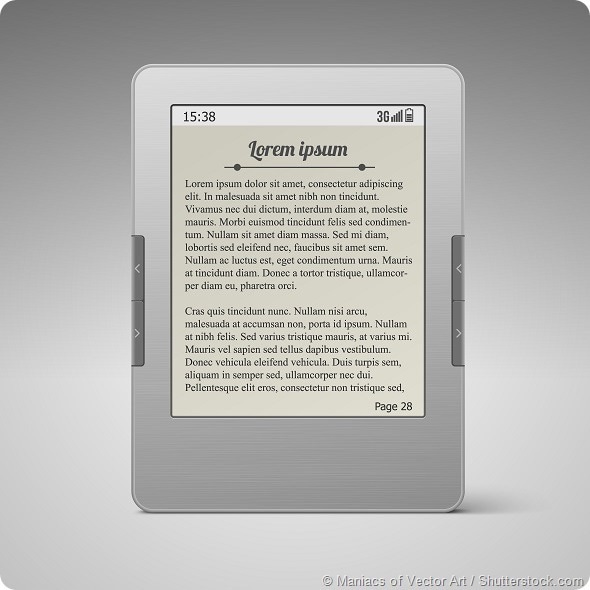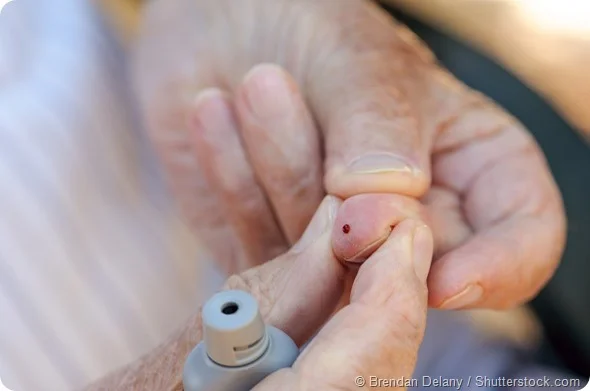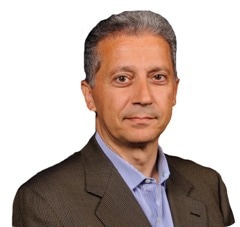Electronic ink is basically what the name says. It's made of ink, the same ink particles that you see on a printed paper that comes out of an inkjet printer. We use black and white pigments that we add certain properties to that allow us to move the pigments around.
If you can imagine being able to put pigments down on a sheet of paper, and then every time you wanted new text, or a new image on that paper to move the pigments around, that's essentially what we do.

In terms of the manufacturing process, we take the black and white pigments that have these properties, and we encapsulate them in little micro spheres that are about 50 microns in diameter, about the width of a human hair.
We then laminate, or coat, these capsules with the pigments on a plastic substrate, which we call our flexible plastic laminant. That gives us basically a surface that holds the capsules in the pigments. We then sandwich this in the middle of two plates that allows us to create an electric field.
Generally what we use is semiconductor electronics, called a thin film transistor array, it is very similar in what is used in displays. What the thin film transistor array allows us to do is to control the electric field on a specific array of dots that make up the image.
Now by controlling the field, one way or another, we get to move the white particles up, or the black particles up. When we want a particular dot to be white we move the white dots up, and when we want the black dots to surface we move the black particles up.
How E Ink Works
What are the main benefits of using electronic ink for healthcare?
The beauty of electronic ink is that it only uses power when you're changing the image. Once you've created the image you want, you can remove all power from the display, and the image will stay there. The ink particles we're moving actually connect with each other and they will stay there.
The reason that's important is that this gives you a way (because you have an extremely low power solution) to maintain an image. As I'll explain in a second, this is very important for certain medical applications.
The other aspect is that we take the microcapsules, which are malleable, and we coat them with this plastic substrate, so that makes a display flexible. It's not a glass display, like your typical display that you see on your television, or your smart phone, or your tablet. Because it's flexible, it's rugged, and it's very lightweight.
Also because we're using pigments, you see it by how it reflects light - exactly the same way that ink on a piece of paper does.
If you remember those three properties, then that helps you understand why we're focusing on certain applications in healthcare.
In what ways has electronic ink been used in healthcare so far and what further uses do you think it could have?
So far electronic ink has been used in a glucose meter from Abbott Diabetes Care. The UK was the place Abbott first introduced this, almost two years ago. Since this is a standard glucose meter, it's used by diabetics to constantly test their blood sugar level.
The reason why Abbott came to us is that personal use meters have been around for a while, but they tended to use reflective glass displays that are not easily read. One of the side effects of diabetes is it impacts your vision, especially as you get older. Abbott wanted a solution that provided a more effective display, more value for their patients, their customers. They wanted a display that was larger and easier to read.

The display of this size is using significantly less power than a traditional display so it's also very practical, as the patient doesn't have to change the batteries often. The display is also lighter, because in this case there's no glass. The field is actually created by essentially plastic components. I could drop this on the floor, I don't have to worry about glass shattering. It's a much more convenient product for their patients.
Please can you outline E Ink’s work with medical packaging companies?
We've partnered with a company called Palladio, The Palladio Group, in Italy which is a pharmaceutical packaging company, they do the secondary packaging that the major pharmaceutical companies package their medication in and ship to customers.
The packaging business was totally focused on reducing cost, because packaging was basically viewed as not being very valuable. We believed we could add value to the packaging using our technology by improving patient care.
One very simple module we created has a microprocessor with a temperature sensor in it, so if I cover the microprocessor, you notice that the display changes and it gives me a warning. One of the things the microprocessor is doing, is it's keeping track of the ambient temperature that it's in. This is important because if you're shipping vaccines, vaccines need to stay within a certain temperature range. Now, this gives you a way of tracking whether your vaccines are still viable, whether the handling restrictions have been violated or not.
The other thing this module does is it has a sensor, in this case we've just had a very simple button. Every time that sensor detects something, it registers the event so you know when events happen. You can build on this basic premise further.
For example, remembering to take medication or remembering if you've taken medication is actually a major issue, especially for patients that have certain diseases like dementia or Alzheimer's. In this case, you can register all of the events, and you could share this information with your doctor and you can actually see the exact time you took your medication. So here we are bringing value to the packaging industry and more importantly, improving health care by helping patients maintain the regiment of their therapy.
This can be taken to a higher level, through the use of a blister pack. Every time I push a pill through the blister packs, I'm breaking one of the RFID segments, so I'm changing the signature. In doing that, whatever RFID detector I have knows exactly which pill I popped at which point in time. I also could track if the patient has not taken the medication.
One of the challenges with Alzheimer's is that patients don’t remember whether they took their medication or not. This technology gives you a way of A, the patient keeping track of whether they take their medication and B, if they don’t take their medication reminding them to do so.
We've been having discussions with pharmaceutical companies about adding intelligence such as if a patient doesn't take their medication when they’re supposed to, you can not only send an alarm to them, saying it's time for you to take the medication, but within a certain amount of time, you can escalate the alarm and contact someone else in the family or a caregiver to call the patient and say "dad, you forgot to take you medication".
The other aspect of it is that pharmaceutical companies have noticed that even patients that take quite important medication for something like cancer or other diseases, that there's as much as a 30% noncompliance with the prescribed therapy for a number of different reasons. It also found that by encouraging the patient to take the medication you can significantly improve compliance.
How do you think the application of electronic ink in hospitals and other healthcare settings will affect healthcare professionals?
There's no direct impact but in hospitals, we believe that by introducing smart packaging it could help it in a few ways. It'll give the health care providers, direct information as to whether the medication is viable and when was the last time the package was handled?
At the same time by providing information on the packaging, we can also provide information about which medication needs to go with which patient. We believe there is an opportunity there to help with the administering of medication within a hospital environment and that's how we believe we can help in a larger sense.
What do you think the future holds for electronic ink in healthcare and how do E Ink plan to contribute?
We are looking at many markets, E Ink is best known for being the display in e-readers and although that continues to be a large part of our business, we’re looking into many other areas from shelf labels, the price that's on storage shelf to badges, to displays in mobile devices, and health care devices.
In addition to applications in the health care area, the other area we’re focusing on is in architecture where we've engaged with architects look at building environments that are more interactive or experiential. The architecture around us is very static, walls come in one color and they don't change. We have projects that we've engaged with different architects, where we're able to change environments and show different colors.
The health care application is the one that we're really interested in for a number of reasons. It's difficult to solve this problem using other ways because the other solutions that we've seen are not very effective, they require that patients take pills, put them in special containers and do manual tracking. We believe that we can enable solutions that are actually viable and add value to it and the markets can be quite large, they can be significantly larger than what we've seen in the e-reader business.
From the impact that we can have on people to the potential of the market, we believe it is a very interesting area for us to pursue and we've partnered with Palladio to pursue this in the coming years.
What are the main challenges that will need to be overcome?
There's a series of challenges, one is finding the right people to talk to. There are not a lot of companies in the packaging business that have Palladio's foresight, which will focus on adding value as opposed to reducing cost.
Second is finding the right partner to establish an integrated solution like we had with the glucose meter. The hardware provides the capability, but what you need is really the software integration that takes that data and converts it into information which is what Abbott did with their online software.
We need to partner with someone that could take this and put together an integrated solution that takes the data that's coming off of the blister pack, the RFID detector and everything else.
Where can readers find more information?
About Giovanni Mancini
With more than two decades of experience in the semiconductor and design automation industries, Giovanni Mancini is presently the Head of Global Marketing at E Ink Holdings, the global leader in electronic paper (ePaper). Since joining E Ink in 2010, Giovanni has been instrumental in the launch of a number of ePaper products and the positioning E Ink as a diversified business beyond eReaders.
His 25 years of experience in the electronics industry include leading engineering and marketing teams in Electronic Design Automation, Communications, Signal Processing and Semiconductor products. Giovanni holds a Bachelor of Electrical Engineering and Master of Electrical Engineering Degree from McGill University in Montreal. Previously, Giovanni has held management positions at Bell-Northern Research, Cadence Design Systems, Mentor Graphics and The MathWorks.